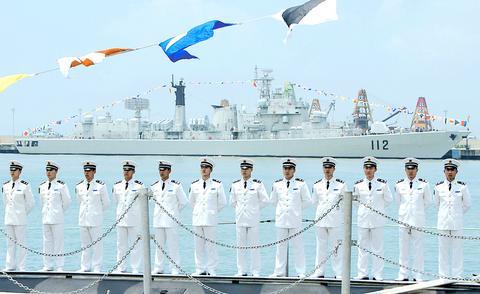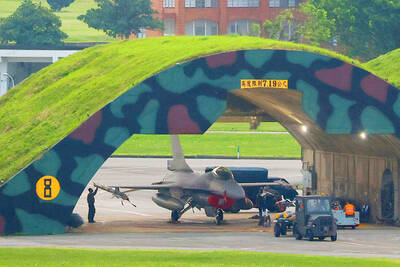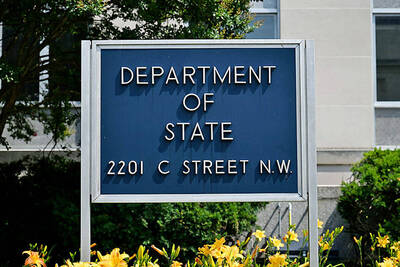China's navy sailed eight warships into Hong Kong yesterday in its biggest show of military force since the former colony's 1997 handover from Britain.
The port call is meant to boost patriotism in Hong Kong, but analysts also said China was flexing its naval muscles to send Taiwan a message discouraging any thoughts on independence.
A vice admiral did not directly address that issue when asked by reporters.

PHOTO: REUTERS
"We are always on call," said Yao Xingyuan (
Yao said the two destroyers, four frigates and two submarines are in Hong Kong until this Wednesday to commemorate the 55th anniversary of the PLA's navy.
Yao said the ships will sail through Victoria Harbor when they depart, giving the territory a good look at them, but he wouldn't say where they were heading next.
The port call comes at time when many Hong Kongers are angered by Beijing's decision to rule out full democracy here in the near future.
About 100 Hong Kong residents visited one ship yesterday morning, waving Chinese and Hong Kong flags as bands played patriotic music.
"As a Hong Konger, as a Chinese, I want to welcome my own navy," said Man Yu-ming, a 45-year-old insurance agent.
"I want to check out the equipment on the ships," said Elaine Ng, who is 50 and unemployed.
The visit was an apparent message to Taiwan, said political expert Ding Xueliang (丁學良) of the University of Science and Technology.
But Ding expressed doubts that a show of force by China would prompt any changes in Taiwan President Chen Shui-bian's (
Defense analysts said any Chinese naval attack on Taiwan would be unlikely to succeed.
China would have difficulty providing enough cover to troops to make an amphibious landing, said Robert Karniol, Asia-Pacific editor of Jane's Defense Weekly, in a telephone interview from Bangkok.
Political scientist Joseph Cheng (
The visit comes as many Hong Kong people demand the right to directly elect their leader in 2007 and all lawmakers in 2008. Many of these had their hopes shattered on Monday when Beijing ruled out such reforms.
The eight warships are the biggest group China has sent here since the 1997 handover. Two warships visited during a port call in 2001.
A PLA spokesman said the vessels are a battle group en route to a training exercise at an undisclosed location. Sailors will be allowed to tour Hong Kong in civilian clothing.
The PLA has stationed troops here since the 1997 handover, but they generally keep a low profile and stay inside their barracks to avoid alarming Hong Kong citizens.

MISINFORMATION: The generated content tends to adopt China’s official stance, such as ‘Taiwan is currently governed by the Chinese central government,’ the NSB said Five China-developed artificial intelligence (AI) language models exhibit cybersecurity risks and content biases, an inspection conducted by the National Security Bureau (NSB) showed. The five AI tools are: DeepSeek, Doubao (豆包), Yiyan (文心一言), Tongyi (通義千問) and Yuanbao (騰訊元寶), the bureau said, advising people to remain vigilant to protect personal data privacy and corporate business secrets. The NSB said it, in accordance with the National Intelligence Services Act (國家情報工作法), has reviewed international cybersecurity reports and intelligence, and coordinated with the Ministry of Justice Investigation Bureau and the National Police Agency’s Criminal Investigation Bureau to conduct an inspection of China-made AI language

BOOST IN CONFIDENCE: The sale sends a clear message of support for Taiwan and dispels rumors that US President Donald Trump ‘sold out’ the nation, an expert said The US government on Thursday announced a possible sale to Taiwan of fighter jet parts, which was estimated to cost about US$330 million, in a move that an expert said “sends a clear message of support for Taiwan” amid fears that Washington might be wavering in its attitude toward Taipei. It was the first announcement of an arms sale to Taiwan since US President Donald Trump returned to the White House earlier this year. The proposed package includes non-standard components, spare and repair parts, consumables and accessories, as well repair and return support for the F-16, C-130 and Indigenous Defense Fighter aircraft,

CHECKING BOUNDARIES: China wants to disrupt solidarity among democracies and test their red lines, but it is instead pushing nations to become more united, an expert said The US Department of State on Friday expressed deep concern over a Chinese public security agency’s investigation into Legislator Puma Shen (沈伯洋) for “secession.” “China’s actions threaten free speech and erode norms that have underpinned the cross-strait ‘status quo’ for decades,” a US Department of State spokesperson said. The Chongqing Municipal Public Security Bureau late last month listed Shen as “wanted” and launched an investigation into alleged “secession-related” criminal activities, including his founding of the Kuma Academy, a civil defense organization that prepares people for an invasion by China. The spokesperson said that the US was “deeply concerned” about the bureau investigating Shen

‘TROUBLEMAKER’: Most countries believe that it is China — rather than Taiwan — that is undermining regional peace and stability with its coercive tactics, the president said China should restrain itself and refrain from being a troublemaker that sabotages peace and stability in the Indo-Pacific region, President William Lai (賴清德) said yesterday. Lai made the remarks after China Coast Guard vessels sailed into disputed waters off the Senkaku Islands — known as the Diaoyutai Islands (釣魚台) in Taiwan — following a remark Japanese Prime Minister Sanae Takaichi made regarding Taiwan. Takaichi during a parliamentary session on Nov. 7 said that a “Taiwan contingency” involving a Chinese naval blockade could qualify as a “survival-threatening situation” for Japan, and trigger Tokyo’s deployment of its military for defense. Asked about the escalating tensions